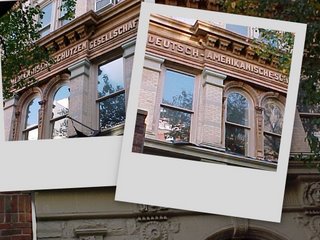
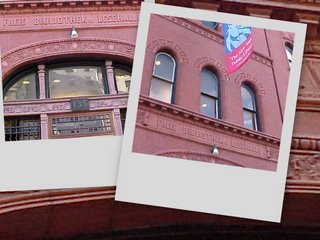
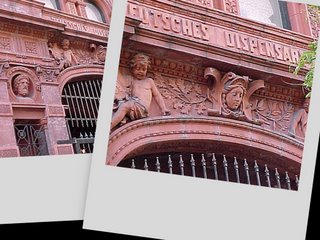
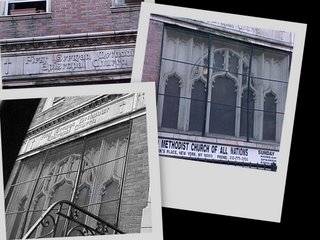

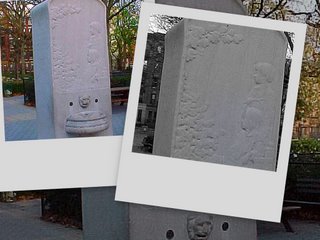
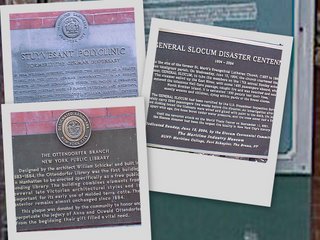
[former deutsch-amerikanishe-schützen gesellschaft @ 12 st. mark’s place, built in 1888—16 years before the tragedy ~ former freie bibliothek u. lesehalle @ 135 second avenue (now ottendorfer branch, new york public library) ~ former deutsches dispensary (later stuyvesant polyclinic) @ 137 second avenue ~ former 1st german methodist episcopal church @ 48 st. mark’s place ~ former st. mark’s evangelical lutheran church (now community synagogue) @ 6th street ~ monument in tompkins square park in remembrance of “the earth’s purest children—young and fair” dedicated by the sympathy society of german ladies (in “the year of our lord mcmvi”) ~ historical markers chronicling kleindeutschland]
kleindeutschland—in what is today’s east village—was the home to over 80,000 germans by the 1870s. (they had started arriving in large numbers during the 1840s.) on the morning of june 15, 1904, that community suffered an unspeakable tragedy.
prior to september 11, 2001, the burning of the general slocum had the highest death toll of any disaster in new york city’s history—catching fire in the east river with approximately 1,300 people on board, including many children. chartered by st. mark’s evangelical lutheran church on east 6th street for their 17th annual excursion to a picnic grounds on long island, the triple deck wood sided paddler burned in the course of 20 minutes on that morning. members of this church—along with their roman catholic and jewish friends and neighbors invited along for the outing—listened to a band play german favorites while adults talked and children romped. a spark—possibly from a carelessly tossed match—ignited a barrel of straw. smoke billowed upward after the excursion passed 90th street: by the time the general slocum passed randall’s island, massive flames began to consume the ship.
the majority of the ship’s lifejackets were worthless because the material then used—cork—had turned to dust over time. rather than keeping these people afloat in this period when fewer people learned to swim, the lifejackets actually absorbed water and pulled people under. the slocum’s six lifeboats were held to the ship by a thick coat of paint, while its fire hoses burst under pressure. the vessel burned to its waterline in 15 minutes. passengers jumped into hell’s gate—new york’s most turbulent waterway—rather than be consumed by the flames in the way their fellow new yorkers jumped from the world trade center nearly a century later.
consider the fact that the titanic went down in the atlantic with over 1,500 souls in the murkey waters of the north atlantic, 380 miles off newfoundland: the slocum consumed the lives of at least 1,021 within sight of horrified onlookers in manhattan, queens, and the bronx. as the tragedy transpired, the river was full of every kind of vessel.
from the residents who found hundreds of bodies washing up on astoria’s shoreline to crews of tugs, fireboats, a police boat, and more than a hundred other vessels that joined the rescue effort (some of which caught fire attempting to fetch passengers from the stricken ship) to sickened newspaper editors who received dispatches from their reporters, the events of that june morning reverberated all over the city. heartbroken crews on boats seeking to offer assistance found exponentially more lifeless bodies of passengers than survivors. [remember the doctors and staff at st. vincent’s hospital who lined up the morning of september 11th, waiting to assist scores of survivors that never came?] those assisting with rescue were unable to contain sobs as the bodies of the general slocum’s doomed passengers—most of them of young children—piled up.
although the population of kleindeutschland had begun to migrate to other areas of the metropolitan area—notably the uptown neighborhood of yorkville—the general slocum tragedy hastened the departure of grief-stricken neighbors and family members. apartments and shops had been left empty in a neighborhood swirling with panic and confusion. nearly everyone in the neighborhood—in which funerals and memorial services went on in shifts for days—had known someone on that ill-fated outing. dazed men who had come home that june 15 to find their wives and children consumed (and dozens had lost entire families), could no longer bear to return to empty apartments that reminded them of their loss. numerous suicides consumed inconsolable survivors. the german theatres, restaurants, fraternal societies, athletic clubs, bookshops, beer gardens, churches, and synagogues serving the immigrant german community and its offspring closed their doors and moved uptown. by the 1910 census, few of that traumatized german community remained.
vestiges remain. at the united methodist church of all nations, 48 st. mark’s, where once the nunc dimittis, collects, and invitatories were said in german, prayers now are heard in english, castellano, and korean. its inscription attests to its former parishioners. clinics and libraries built by those erstwhile new americans are now utilized—in another century—by new yorkers of many religions and national backgrounds. maritime laws promulgated in the wake of the general slocum tragedy now protect all americans.
2 comments:
Great blog post!
-- Sheri Clemons (shericlemons@gmail.com)
That was a part of New York City history which I never knew. Within this context, the saying "there goes the neighborhood" certainly takes on new meaning.
Post a Comment